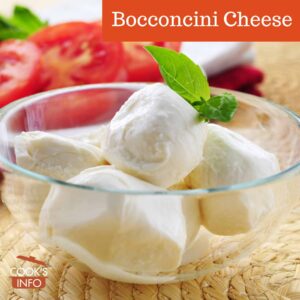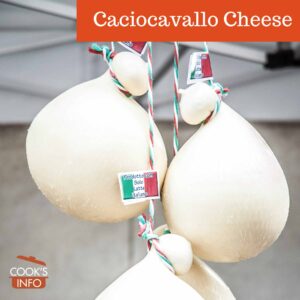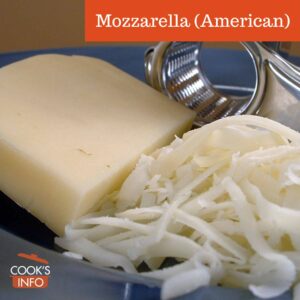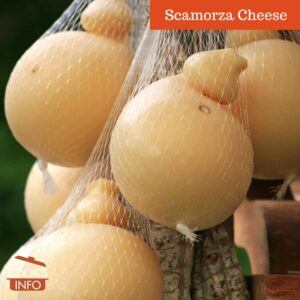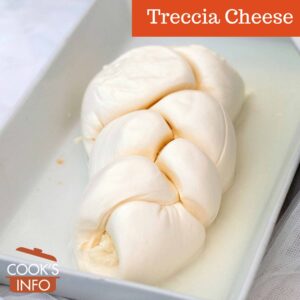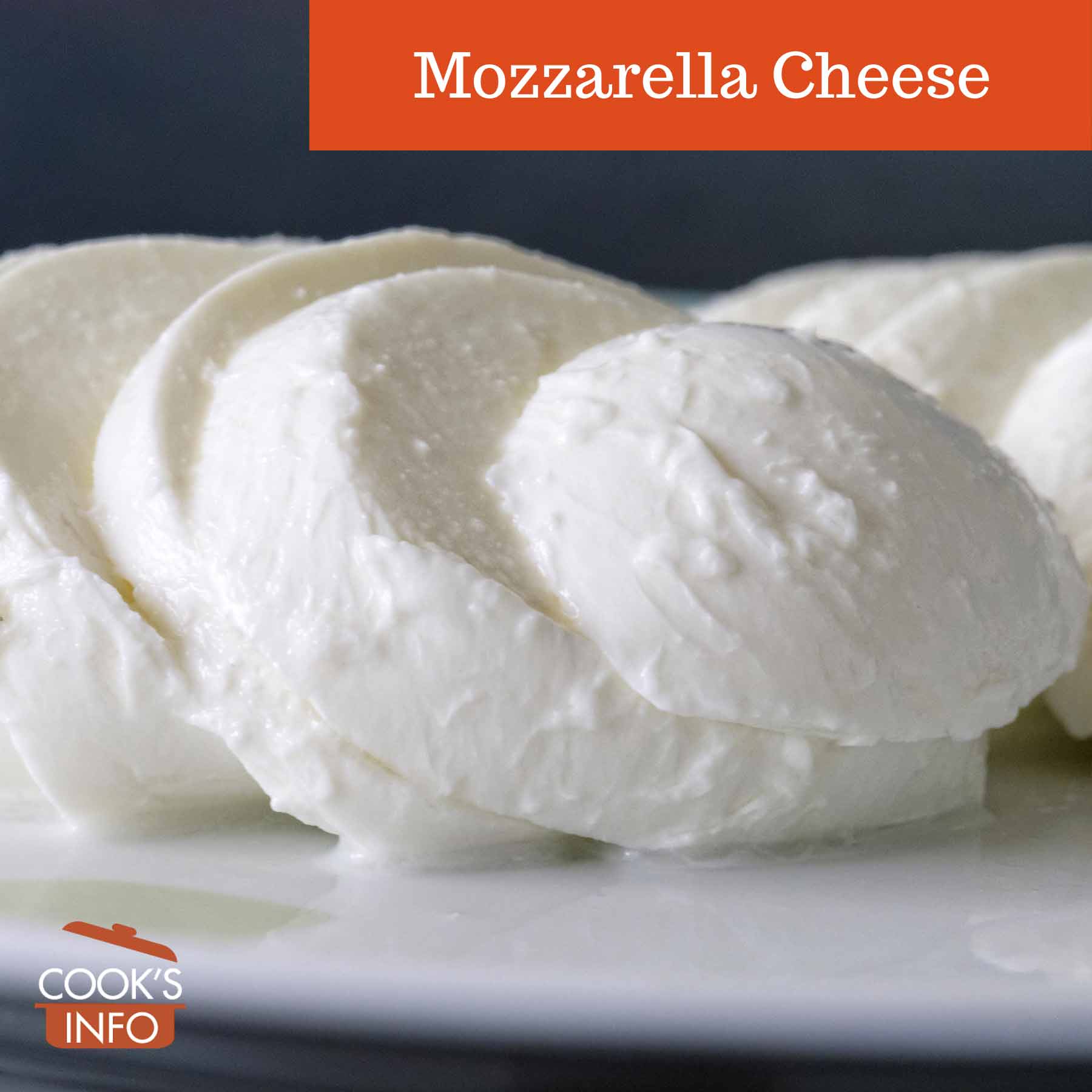
Mozzarella cheese ball sliced. Max Straeten / morguefile.com
Mozzarella is a fresh, stringy Italian cheese made from water buffalo milk. Its full name is “buffalo milk mozzarella”, or “Mozzarella di Bufalo” in Italian.
The cheese is pure white. It has a creamy texture and a slight fresh tang to it, but otherwise little other taste. If it has a sour taste, it is getting old.
The cheese is sold in soft, semi-spongy balls whose stringy texture is somewhat reminiscent of a cooked chicken breast. The balls will have a very thin skin on them. You’ll often see them in a tub of liquid, which some people think is water, but which is actually some of the cheese’s own whey.
Two of the better brands of buffalo milk mozzarella are considered to be Garofolo and Delizie Alburnine.
This style of mozzarella is also made in Romania and Bulgaria.
Water buffalo milk is whiter than cow’s milk. It is also used to produce Indian paneer.
See also: Mozzarella (American)
How mozzarella is made
Whole water buffalo milk is pasteurized, then cooled to 32 C (90 F.) Rennet is added to curdle the milk, then the curd is cut. The curd is allowed to sink to the bottom, and rest for a bit in the whey, so that the acids can soften the curd. Then, it is washed with hot water 93 C (200 F) flowing through it, then stirred with paddles. The really hot water and the agitation make the curd first coagulate into one lump, then spin out in strands which are stretched, cut off in pieces and rolled by hand into balls. Rolling by hand preserves the nature of the strands, giving the fresh mozzarella its layered texture, and traps a bit of the whey still in the balls between the layers. The balls are then cooled, salted and sent off for sale.
Real mozzarella quality standards
Real mozzarella is a PDO protected cheese in Europe as of 1996.
Its production quality is administered by a group of 200 producers called the “Consorzio di tutela della Mozzarella di bufala (Consortium for the Protection of Buffalo Milk Mozzarella.) [1]The consortium was disbanded by Luca Zaia, Italy’s Agriculture Minister, on 19 January 2010, for failing to protect the standards of the cheese. His ministry had tested 530 samples of the cheese, and found that 25% of the samples being sold as pure buffalo milk mozzarella were in fact adulterated with at least 30% cow’s milk. Even the president of the consortium, Luigi Chianese, was alleged to have adulterated his own cheeses. “A novembre i numerosi controlli nella grande distribuzione hanno rivelato che nel 25% dei campioni analizzati, le mozzarelle non erano vere Mozzarelle di bufala poiché contenevano almeno il 30% di latte di vacca.” — Mozzarella di bufala, consorzio scandalo Zaia: «Il presidente annacquava il latte». Rome: Il Messsaggero. 20 January 2010.
The PDO branded cheese (the logo is red and green, with the head of a water buffalo on it) can only be made in the Apulia, Campania and Lazio areas of Italy.
Fiore di Latte Mozzarella
This is the Italian name for mozzarella made from cow’s milk instead of buffalo milk, as it is anywhere outside Apulia, Campania and Lazio in Italy.
It is almost as white as buffalo milk mozzarella, but doesn’t quite have the same texture. It is more rubbery. In making the cheese, the emphasis is more on its having a somewhat longer shelf life than in being eaten fresh.
In North America, any “fresh” mozzarella you buy is almost certainly going to be made from cow’s milk and therefore actually be “Fiore di Latte.”
In fact, in North America, you may actually be better off buying Fiore di Latte (fresh cow’s milk Mozzarella) rather than buffalo milk mozzarella, simply because the buffalo milk mozzarella will likely have travelled from Italy and therefore not be as fresh. When the buffalo milk mozzarella is not absolutely fresh, it will have somewhat of a sour taste, whereas the Fiore di Latte’s taste is stable for a bit longer.
Cooking Tips
Buffalo milk mozzarella is so moist and soft that it melts quickly — the heat alone from just-drained pasta will melt it.
In North America, it may be better to use any fresh-style mozzarella for eating fresh, rather than for cooking, as it is expensive and the flavour when served fresh is so good. Use the cheaper North American style mozzarella for cooking.
Nutrition
Fresh mozzarella has 87 calories per ounce, and is 24% fat, as well as 51% water, 20% protein, 4% carbohydrate, and 2% ash.
Per 100 g (3.5 oz), genuine:
Calories 301
Fat 25 g
Saturated fat 19 g
Calcium 515 mg
Storage Hints
Store in fridge. If your fresh mozzarella doesn’t come in a tub of liquid (which is actually whey from the cheesemaking), store it in the fridge in fresh water and use within 2 to 3 days at the most. Change the water daily.
History Notes
On a good day, the history of the mozzarella seems to stretch back to the Romans, and even to Egypt before that.
The real curiosity, though, would be how water buffalo, which are native to south-east Asia, got to Italy in the first place, and the truth is, no one knows for sure. The best stories involve Anthony and Cleopatra, with Anthony sending the water buffalo and the cheese recipe back to Caesar in Rome.
Other sources say the buffalo could have been introduced by any invader, or by the Romans, or could have just always been there. Some say the Crusaders brought them back to Italy.
What is certain, however, is that mozzarella originated in the southern Italian regions of Campania and Sicily.
After World War Two, Italy initiated a water buffalo breeding program to optimize the yield and characteristics of the milk for mozzarella production with the optimal balance of protein and fat.
In 2003, a farmer in Vermont started a herd of 50 water buffalo, to see if he could make a go of making something close to the real thing there.
In the spring of 2008, under pressure from the EU, Italy ordered a recall of some types of mozzarella cheese potentially contaminated with a cancer-causing dioxin. The cheeses recalled were made by some 25 companies in Italy’s Campania region. The dioxin was believed to have come from the fumes of garbage burning in the Naples area during the garbage crisis there at the time.
A second scandal emerged in early 2010, when it was found that some mozzarella cheese being sold as pure buffalo milk cheese in fact contained up to 30% of the cheaper cow’s milk.
Language Notes
The name probably comes “mozzare”, meaning to cut off, referring to cutting off the strands of cheese. Mozzarella would mean something like “little cuttings.”
Sources
Kinetz, Erika. Italian makes mozzarella in India. Associated Press. 14 April 2011.
Owen, Richard. Italian buffalo mozzarella being diluted with cow’s milk. London: The Times. 20 January 2010.
Riedl, Sue. When not in Rome, eat cheese like you’re in Rome. Toronto, Canada: The Globe and Mail. 7 June 2011.
Squires, Nick. Buffalo mozzarella inquiry collapses after chief’s own cheese fails purity test: An inquiry by farmers into the adulteration of Italy’s prized buffalo mozzarella has collapsed after allegations that its leader watered down his own cheese with cheaper cow’s milk. London: The Telegraph. 20 January 2010.
Stewart, Phil. Italy recalls contaminated mozzarella cheese. Reuters. 28 March 2008.
Types of mozzarella
Bocconcini Cheese
Caciocavallo Cheese
Mozzarella (American)
Scamorza Cheese
Treccia Cheese
References
| ↑1 | The consortium was disbanded by Luca Zaia, Italy’s Agriculture Minister, on 19 January 2010, for failing to protect the standards of the cheese. His ministry had tested 530 samples of the cheese, and found that 25% of the samples being sold as pure buffalo milk mozzarella were in fact adulterated with at least 30% cow’s milk. Even the president of the consortium, Luigi Chianese, was alleged to have adulterated his own cheeses. “A novembre i numerosi controlli nella grande distribuzione hanno rivelato che nel 25% dei campioni analizzati, le mozzarelle non erano vere Mozzarelle di bufala poiché contenevano almeno il 30% di latte di vacca.” — Mozzarella di bufala, consorzio scandalo Zaia: «Il presidente annacquava il latte». Rome: Il Messsaggero. 20 January 2010. |
|---|


